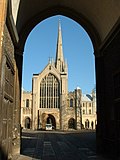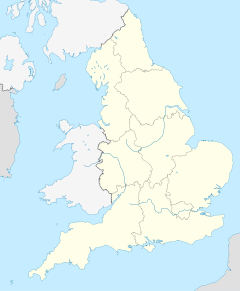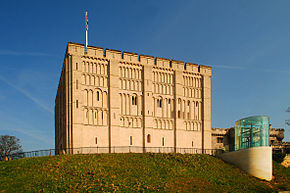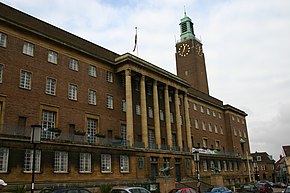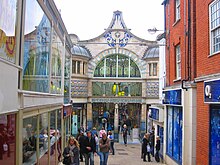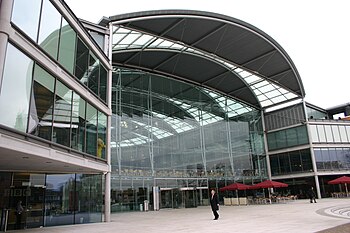Norwich
| Norwich | |||
|---|---|---|---|
|
|||
| Coordinates | 52 ° 38 ′ N , 1 ° 18 ′ E | ||
|
|
|||
| Residents | 193,821 (as of 2016) | ||
| surface | 39.02 km² (15.07 mi² ) | ||
| Population density: | 4967 inhabitants per km² | ||
| administration | |||
| ZIP code section | NR1 - NR16 | ||
| prefix | 01603 | ||
| Part of the country | England | ||
| region | East of England | ||
| Shire county | Norfolk | ||
| District | Norwich | ||
| ONS code | 33UG | ||
| British Parliament |
Norwich North Norwich South |
||
| Website: www.norwich.gov.uk | |||
Norwich [ ˈnɒrɪdʒ ], also [ ˈnɒrɪtʃ ] is a university town in eastern England and the capital of County Norfolk . The townscape is characterized in particular by a well-preserved medieval town center. Despite the approximately 190,000 inhabitants, Norwich has retained a certain small-town character due to its rather remote location.
geography
Norwich is on the small River Wensum near the Norfolk Broads , eight miles northwest of Attlebridge
history
From the icers to the Normans
The city has its origins in several first Icenian and then Anglo-Saxon settlements located at a ford of the river Wensum. One of these settlements was called "Northwic". The name "Northwic" was first handed down on coins struck during the reign of King Æthelstan (King of the English from 927 to 939). When Norwich was almost completely destroyed by the Vikings in 1004 , the city was already one of the largest settlements in England. This development was based on the city's advantageous location on the Wensum River and its proximity to the North Sea . This favored the trade in goods from central England, Russia , Scandinavia , the Rhineland and what was then Flanders . After the conquest of England by the Normans in 1066, they began building a wooden fortification, which was replaced by a stone structure, Norwich Castle , around 1100 . At the same time, construction began on the Holy Trinity Cathedral , founded by Bishop Herbert de Losinga , which took 50 years to complete. Both buildings, which have been expanded and rebuilt several times, are now central eye-catchers in the cityscape. There is also a Roman Catholic cathedral (see below).
Middle Ages to modern times
Norwich received city rights in 1194 from Richard I. Norwich was not spared from major fires, epidemics and political unrest during the Middle Ages. For example, in 1507 two fires destroyed most of the city's buildings. In contrast to today's situation, medieval Norwich could only be compared in terms of size and importance with London at the time . The city wall, built from 1297 to 1344, had a length of 4 km and enclosed an urban area that exceeded that of London by a lot. Remnants of this city wall are still preserved in a few places. At the beginning of the 14th century, Norwich began to develop into a center of weaving and trading in fabrics and clothing in England and beyond. The city only lost this importance in the course of the industrial revolution in the 19th century and the introduction of factory-made fabrics. The "heraldic animal" of the weavers, the canary , can still be found today in the emblem of the city's football club, the ' Canaries ', and testifies to the importance of this branch in the city's heyday.
The 19th and 20th centuries
The number of the urban population doubled, mainly due to the influx from rural areas, from 1810 to 1870 to around 80,000 inhabitants and the living space began to expand beyond the city wall. This and the increasing traffic meant that the city wall built in the Middle Ages was partially torn down and replaced by wider traffic routes. The construction of the railway line and three stations, of which only the 'Thorpe Station', which opened in 1844, still exists today, brought about further changes in the character of the city. Before the station was built, it was often easier to travel from Norwich to Amsterdam than to London due to geographical isolation . From 1900 on, a tram also did its job , but only for 30 years. In 1910 the Roman Catholic Cathedral of St. John the Baptist , begun in 1882, was consecrated at the highest point of the city center , episcopal church of the diocese of East Anglia and one of the most important examples of English neo-Gothic .
In 1938, accompanied by some criticism of its architecture, the town hall, which still dominates the townscape on the market square today, was inaugurated. During the Second World War , Norwich was bombed more than forty times. In addition, about 44 V2 rockets fell on Norwich. Several thousand houses, factories and churches were damaged. The reconstruction took place mainly during the 1950s.
In 1963, the University of East Anglia (UEA) was established as part of a UK government's program to establish new universities .
Attractions
Norwich is believed to have owned 35 medieval churches in addition to Norwich Cathedral after World War II , many of which were closed in the 1970s. Famous are the parish church of St Peter Mancroft in Perpendicular Style and St. Andrew in St. Andrew's Street with a dance of death in stained glass. The Castle and St. Andrew's Hall, a former Dominican church, are also noteworthy.
politics
City Council
In the city parliament, since the election on May 5, 2011, the Labor Party has 18 council members, the Greens 15, the Liberal Democrats 4 and the Conservative Party 2 council members.
Twin cities
| city | country | since |
|---|---|---|
| El Viejo |
|
1996 |
| Koblenz |
|
1978 |
| Novi Sad |
|
1989 |
| Rouen |
|
1959 |
economy
Norwich was an important industrial city that u. a. famous for its footwear industry that has gone under. Production of the world-famous mustard brand Colman's , which belongs to the Unilever Group, is to be closed in 2019 and relocated to Burton-on-Trent and Germany.
The general decline of English industry in the last decades of the 20th century has been curbed in Norwich by newer urban development programs and the development of the service economy. The Norfolk and Norwich University Hospital , the central hospital for the region , was built west of Norwich . The “Riverside Entertainment Complex”, which houses cinemas, restaurants and shops, was built on the waterfront near the train station. The Millennium Library (called 'The Forum') on the market square, a complex of glass and steel, houses the city's public library, the Tourist Information Center , the BBC's regional studios and restaurants.
The market square, located near the town hall and forum, is considered the oldest and largest street market in England. Next to it is the Victorian Art Nouveau shopping arcade Royal Arcade .
The Institute for Food Research (IFR) with the National Collection of Yeast Cultures and the two institutions in the field of molecular plant research, the Sainsbury Laboratory and the John Innes Center, are located in Norwich Research Park , west of the city . Bayer CropScience operates a factory here.
The two resident newspapers are the Norwich Evening News and the Eastern Daily Press . Norwich has an international airport, Norwich International Airport , which is mainly served by KLM from Amsterdam.
Sports
The city football club Norwich City , also known as The Canaries , has played eight seasons in the Premier League , the top division of England, and will be back in the Premier League from the 2019/20 season . The club's greatest successes are winning the League Cup twice and finishing third in the Premier League in 1992/93 . The club plays its home games on Carrow Road .
Famous pepole
sons and daughters of the town
- Peter Barlow (1776–1862), writer and physicist
- William Beloe (1756–1817), writer, translator and editor
- John Curtis (entomologist) (1791–1862), entomologist and illustrator
- Saraya-Jade Bevis (* 1992), WWE wrestler
- Richard Bloomfield (born 1983), tennis player
- Christopher Boardman , sailor
- Beryl Bryden (1920–1998), jazz and blues musician
- Steve Buttle (1953–2012), football player
- Edith Cavell (1865–1915), nurse, executed as a spy in the First World War
- Olivia Colman (born 1974), actress
- William Crotch (1775–1847), composer and organist
- Cathy Dennis (* 1969), singer, songwriter and music producer
- Frank Doubleday (1945–2018), actor
- Kit Downes (* 1986), jazz musician
- Margaret Fountaine (1862–1940), butterfly researcher
- Elizabeth Fry (1780–1845), prison reformer
- Mike Gascoyne (* 1963), automotive engineer
- Freddie Gavita (* 1985), jazz trumpeter
- Robert Greene (1558–1592), writer
- Charles D. Hall (1888–1970), production designer
- Robert Hinde (1923–2016), behavioral scientist
- Julian Jarrold (* 1960), film director and producer
- Jocelyn Lovell (1950-2016), Canadian cyclist
- Arthur Henry Mann (1850–1929), organist and composer
- Thomas Morley (1557 / 1558–1602), Renaissance composer
- William of Norwich (1132–1144), victim of a ritual murder legend
- Juliana of Norwich (c. November 8, 1342 - c. 1416), saint, mystic, author of the book The Revelations of Divine Love
- Matthew Parker (1559–1575), Archbishop of Canterbury
- Barry Pinches (* 1970), snooker player
- Philip Pullman (born 1946), writer
- Ambrose Reeves (1899–1980), Anglican and anti-apartheid activist
- Tony Sheridan (1940-2013), co-founder of beat music
- Sheridan Winn , writer
- Robert Woodhouse (1773-1827), mathematician and university professor
Other famous people
- Stuart Ashen , comedian, actor, writer (* 1976), lives and works in Norwich.
- Ben Bradshaw , journalist and Labor politician (* 1960) grew up in Norwich.
- Thomas Browne , doctor, writer, polymath (1605–1682), lived in Norwich from 1636 and was knighted here.
literature
- Carole Rawcliffe and Richard Wilson: Medieval Norwich . - London: Hambledon & London, 2005. - ISBN 1-85285-449-9
- Carole Rawcliffe and Richard Wilson: Norwich since 1550 . - London: Hambledon & London, 2005. - ISBN 1-85285-450-2
Web links
- City administration
- Illustration of the city in 1559 in Civitates orbis terrarum by Georg Braun
- Norwich City Football Club
- University of East Anglia
- Norwich University of the Arts
- The Sainsbury Laboratory
- John Innes Center
Individual evidence
- ↑ Great Britain: parts of the country and larger cities. Retrieved on December 17, 2016
- ↑ James Hooper: Jarrolds's official guide to Norwich . Jarrold & Sons, Norwich and London 1900, p. 11.
- ↑ BBC News May 10, 2011
